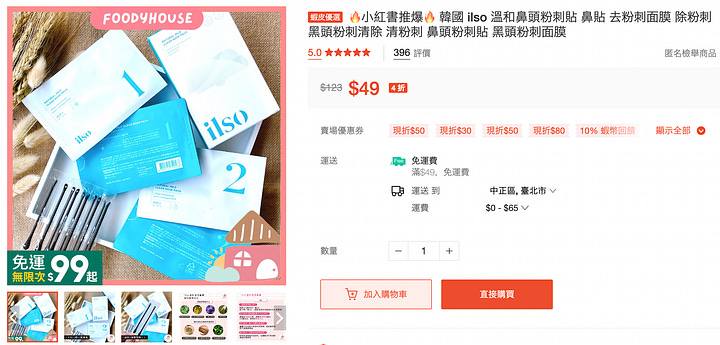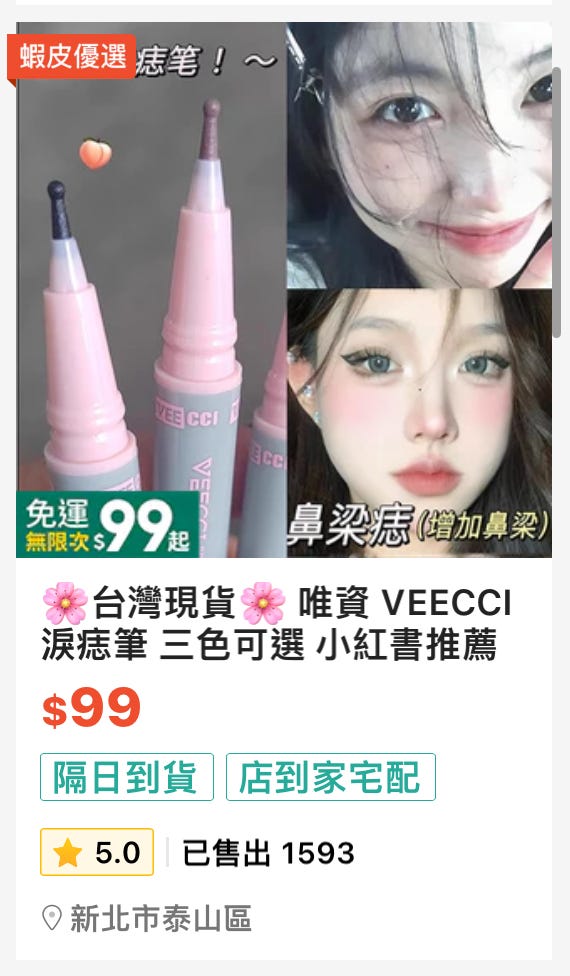Why Xiaohongshu is RED Hot for Taiwan Gen-Z Consumers
Why has Chinese social platform Xiaohongshu become one of the most popular social apps for Taiwanese Gen-Z?
Gen-Z Warm to New Chinese Platform
Scroll through the top cosmetics search terms for best-selling items on the e-commerce platform Shopee and you will notice the keyword 小紅書爆款/小紅書推薦(Xiaohongshu hit product or recommendations).


小紅書/Xiaohongshu directly translated as Little Red Book, but also known officially in English as RED, has become one the most popular social media platforms in Taiwan, especially with Gen-Z and younger users and predominantly females.
Xiaohongshu can best be understood as a mix of Instagram, Pinterest, and Etsy, where users can follow a wide range of content, including livestreams, videos, influencers, bloggers, musicians, and more. Xiaohongshu is especially popular for travel, beauty, and lifestyle content. Of course, like other Chinese social platforms, such as TikTok, it is backed by a powerful recommendation engine that constantly serves up a personalized content feed that keeps users engaged.
Young Taiwanese Cosmetic Shoppers Roll Out the RED Carpet for Xiaohongshu
Xiaohongshu does not have a physical presence in Taiwan, which is unsurprising given the current political climate. Nevertheless, it has managed to become one of the most popular and influential apps in Taiwan. At the time of writing, it ranks as the second and third most downloaded social media app on the iOS and Google Play Store, respectively.
As mentioned, Xiaohongshu is particularly popular in Taiwan for cosmetic and beauty recommendations from influencers. It's not only a major search term on e-commerce platforms, but some of the biggest retailers have also taken note. Healthcare and beauty giant Watsons has added a "Xiaohongshu recommendations" section to its official website. POYA has begun to also stock hit products from the platform.
In 2022, cosmetics imported from China surpassed those from Japan and Korea, with many experts attributing this shift to Xiaohongshu's impact on buying behavior.
It's clear that Xiaohongshu is not just a flash in the pan and is now majorly influential in the way young Taiwanese consume and behave. However, because Xiaohongshu exists in such a grey area, there has been relatively little discussion on this impact and also its scope as a marketing channel for brands wanting to target these younger consumers.
Understanding the Rise of Xiaohongshu
I reached out to Taiwan influencer marketing expert Jill Tsai to get her insights on the rise of Xiaohongshu in Taiwan.
Who Uses Xiaohongshu in Taiwan?
The key consumers for Xiaohongshu are young female office workers who have just entered the workforce and begun to have some discretionary income. Many of the beauty products that influencers push on Xiaohongshu or cheaper, so they are attractive to these consumers.
What is the Reason for Xiaohongshu's Sudden Rise in Popularity?
Well, Instagram has been popular for a long time and is still the top channel in terms of marketing, but I think for Taiwanese users, the big difference between Instagram and Xiaohongshu is that the content feels more real, especially when you are talking about influencer content.
Taiwanese influencers on Instagram are driven by the money they get from brands or they have sales or conversion targets. This has led to influencer recommendations becoming less and less reliable and the content they produce more obviously commercial focused and led by the brands they are working with. Basically, Taiwanese influencers just have too much commercial pressure now and their output has become stale.
On Xiaohongshu, influencers are more reliant on traffic and impression metrics for their income, so their judgments and recommendations feel more organic and reliable. They are happy to criticize products they do not like, which rarely happens on Instagram. So they produce content that is not only trustworthy but also more interesting as they are free to do whatever they want.
Additionally, Xiaohongshu is more full of actual useful information, whereas Instagram feels like just a lot of pretty images. For example, Xiaohongshu is a really good place to go for travel information and finding out the best hotels or cafes in a city. It has a lot of practical information on top of beautiful images and videos, and many Taiwanese are using it when traveling abroad to plan their trips.
Then there's the sheer scale of content to consider. China is an enormous market with millions of content creators, and since we are also Chinese speakers, there is an obvious gravitational. While there's a fair amount of low-quality content, there is also a lot of really interesting content, that frankly is better than Taiwan and usually influencers have bigger budgets. It's not just low-brow content as well, but there is a lot of things like art and poetry on the platform.
Xiaohongshu is really good for wild content that you would never see in Taiwan. Influencers in China will do anything for traffic and they jump on the latest trends immediately. So I think for Taiwanese it is just more exciting, every time you open the app you can expect to see something crazy.
What Has Been the Influence on the Domestic Market and Marketing in Taiwan?
In the luxury sector, many VIP shoppers use Xiaohongshu to research products and trends. It's common for brands to receive requests based on what customers have seen on the platform. Luxury brands in Taiwan have taken notice, and while they won't use the platform for marketing, they do use it for research.
We have also seen overseas brands working with Taiwan influencers on Xiaohongshu. I think they are realizing the potential for the platform as a way to target local consumers. Although this is all quite nascent, you are seeing more Taiwan influencers on Xiaohongshu now.
At the same time, I don't see much scope for local brands to use the platform for marketing. After all, the e-commerce functions are not open to Taiwan consumers. Moreover, people are generally using it for recommendations for cheaper Chinese products, and then going to either Shopee or Taobao to order cross-border.
What do you see as the future potential for Xiaohongshu in Taiwan?
Honestly, I see it as a good channel for more unique, influencer-driven brands here, but I don't think it will ever be a major part of the Taiwan marketing mix. It will grow in terms of the size user base and have its place, but brands can't buy advertising on the platform and are really limited in what they can do and which consumers they can target.
Conclusion
It is clear that Xiaohongshu influences what young Taiwanese people buy and how they travel. Take a look at DCard, the discussion forum targeted for Gen-Z and you will see discussions on Xiaohongshu products and content nearly every day.
However, because it exists in such a gray area, it's really hard to measure its impact or potential. After all, it's not an app made for the Taiwanese market, and most of the content isn't originally geared toward Taiwanese consumers.
There also are few case studies of it being used as a marketing tool to target Taiwanese consumers, but what's true is that the eyeballs are there, and these are eyeballs looking for advice on what to buy. So watch this space, as it seems that eventually, there will be a solid marketing case or model for Xiaohongshu in Taiwan.






